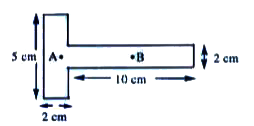Four particles each of mass 1 kg are at the four corners of a square of side 1m. The M.I of the system about a normal axis through centre of square is Solution in Telugu
6kgm2
1.2kgm2
2kgm2
2.5kgm2
The correct Answer is:C
Step by step video, text & image solution for Four particles each of mass 1 kg are at the four corners of a square of side 1m. The M.I of the system about a normal axis through centre of square is by Physics experts to help you in doubts & scoring excellent marks in Class 11 exams.
Topper's Solved these Questions
- BOOK - AAKASH SERIESCHAPTER - SYSTEM OF PARTICLES AND ROTATIONAL MOTIONEXERCISE - EXERCISE - 361videos
SYSTEM OF PARTICLES AND ROTATIONAL MOTION
- BOOK - AAKASH SERIESCHAPTER - SYSTEM OF PARTICLES AND ROTATIONAL MOTIONEXERCISE - EXERCISE-I (Centre of Mass)40videos
SYSTEM OF PARTICLES AND ROTATIONAL MOTION
- BOOK - AAKASH SERIESCHAPTER - SYSTEM OF PARTICLES AND ROTATIONAL MOTIONEXERCISE - EXERCISE - 1B51videos
SYSTEM OF PARTICLES AND ROTATIONAL MOTION
- BOOK - AAKASH SERIESCHAPTER - SURFACE TENSIONEXERCISE - ADDITIONAL PRACTICE EXERCISE (PRACTICE SHEET (ADVANCED) INTEGER TYPE QUESTIONS )8videos
SURFACE TENSION
- BOOK - AAKASH SERIESCHAPTER - THERMAL PROPERTIES OF MATTEREXERCISE - ADDITIONAL PRACTICE EXERCISE (LEVEL - II) PRACTICE SHEET (ADVANCED) Integer/Subjective Type Questions2videos
THERMAL PROPERTIES OF MATTER
Similar Questions
The C.M of a uniform card board cut in .T. shape as shown in figure is
 04:11View Solution
04:11View SolutionThree identical spheres each of radius R are placed touching each other on a horizontal table. The centre of mass of the system is located
01:07View Solution(A) : Position of centre of mass of a body (w.r.t body frame) is independent of co-ordinate system.
(R ) : Internal forces do not effect the motion of centre of mass.01:18View SolutionIf the work done in blowing a soap bubble of volume 'V' is W, then the work done in blowing a soap bubble of volume '2V' is
03:27View SolutionA constant pressure gas thermometer has a volume of 200cc, 273.2cc and 525 .1cc at 0°C, 100°C and boiling point of sulphur respectively. The resistance possessed by a platinum wire at the same temperatures as above are 2.000Ω,2.778Ωand5.280Ω respectively. Estimate the boiling point of sulphur on the basis of the two sets of observations.
04:19View SolutionFour particles each of mass 1kg are at the four corners of square of side 1m. The M.I. of the system about a normal axis through centre of square is
02:59View SolutionFour particles of masses m, m, 2m and 2m are placed at the four corners of square of side a. Find the centre of mass of the system.
View SolutionFour particles each of mass m are kept at the four corners of a square of edge a. Find the moment of inertia of the system about an axis perpendicular to the plane of the system and passing through the centre of the square.
View SolutionFour particle of mass m each are placed at four corners of a square ABCD of side a. Point O is the centre of the square. Moment of inertia of all four particles about an axis passing through
View SolutionFour spheres of radius r each of mass m placed with their centres on the four corners of the square of side 'a'. The M.I. of the system about an axis along one of the sides of square is :
View SolutionFour small spheres each of radius .r. and mass .m. are placed with their centres at the four corners of a square of side .L.. The M.I. of the system about any side of square is
View SolutionFour particles each of mass.m. are placed at the corners of a square of side .U. The radius of gyration of the system about an axis normal to the square and passing through its centre is:
05:03View SolutionFour small spheres each of radius .r. and mass.m. are placed with their centres at the four corners of a square of side .L.. The M.I. of the system about any side of square is
View SolutionFour particles each of mass 1 kg are at the four corners of a square of side Im. The M. of the system about a normal axis through centre of square is
04:25View SolutionFour particle each of mass 1kg are at the four corners of a square of side 1m. The work done to move one of the particles to infinity
View Solution

